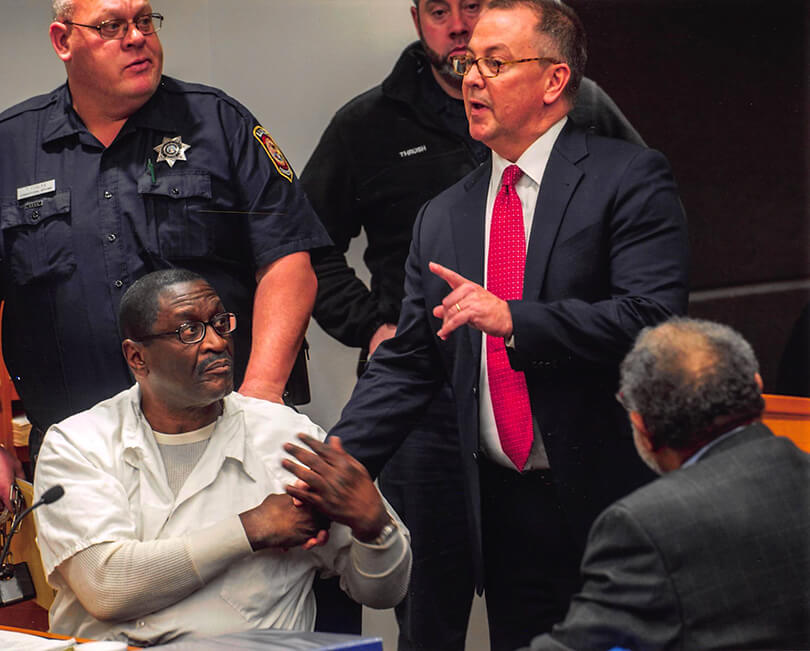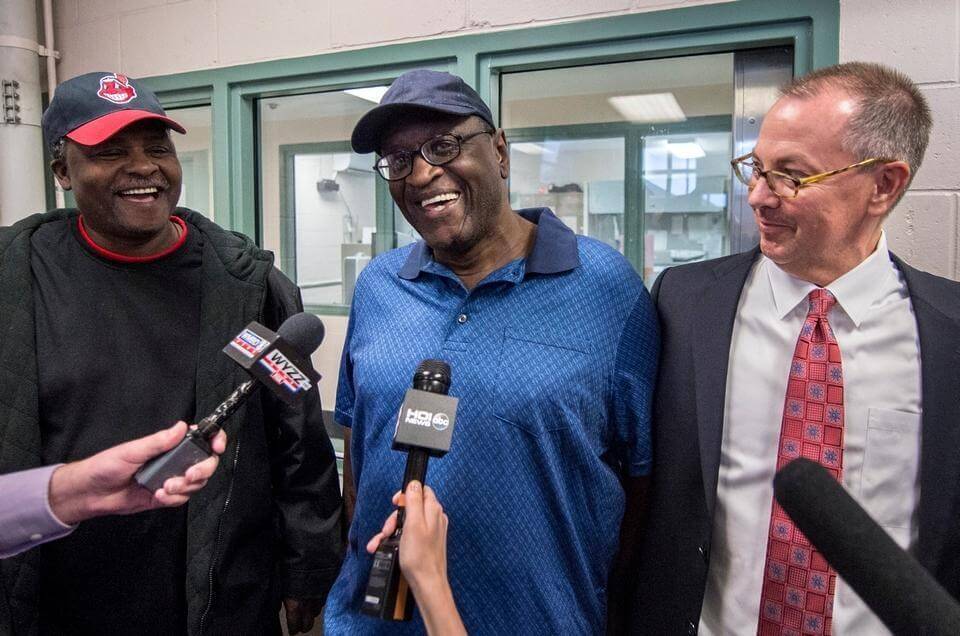Imagine if you were wrongly convicted for murdering a police officer and sentenced to life in prison, continuously maintained your innocence, and eventually had a judge order a new trial after serving 47 years in prison. It sounds like the premise of a Hollywood movie.
Unfortunately, this case was very real for Cleve Heidelberg, who died only ten months after being released from prison on bond, awaiting his newly granted trial. Police and prosecutorial misconduct drove Heidelberg’s conviction, despite early evidence pointing to the actual killer. The decades-long case started unraveling when our experienced investigative team stepped in—convinced of Heidelberg’s innocence.
In this article, we’re going to explore the wrongful conviction of Cleve Heidelberg and the details of the crime and the misconduct that lead to Heidelberg spending nearly half a century behind bars.
The Crime
On May 26, 1970, at approximately 1:30 a.m., a botched robbery occurred at the Bellevue Drive-In movie theatre outside Peoria, Illinois. The perpetrator tied up the projectionist with a thin cord and then forced the office manager over to the safe. The projectionist, however, was able to untie himself and call the police.
As the perpetrator and the office manager were outside the building where the safe was located, a police car drove into the theatre’s parking lot, spotting the couple. When the perpetrator saw the car, he pulled a weapon. He fired three shots into the vehicle, killing its driver, Peoria County Sheriff Sergeant Raymond Espinoza. The perpetrator then forced the office manager into a blue Rambler automobile, speeding off.
An informant who had been in the police car with Sergeant Espinoza, Jerry Lucas, Jr., notified authorities of the shooting on the police car’s radio. A police chase ensued, with the Peoria County Sheriff’s Department and the Peoria Police Department pursuing the perpetrator. At one point, where the streets of Blaine and Butler intersected, the perpetrator attempted a right turn at a high rate of speed, crashing the car into another parked vehicle.
The perpetrator ran off, losing the police in the process. About 30 minutes later, Heidelberg got a call about his crashed blue Rambler at the intersection of Blaine and Butler. You see, earlier that night, Heidelberg loaned his car to Lester Mason, who then loaned the vehicle to the perpetrator.
Not knowing what had occurred, Heidelberg made his way to the location of his crashed car, where police found him, handcuffed him, laid him on the ground, severely beat him (while handcuffed and laying down), and commanded K-9 dogs to attack him as well. After the brutal police attack, Heidelberg was taken to the hospital, where he received five stitches for a cut over his left eye. He then was taken directly to the Peoria County Jail, where he was put into a police lineup, newly stitched and swollen.
The Evidence
The Police Lineup
The police officers proceeded to conduct a highly suggestive lineup. Heidelberg’s bandage over his stitches was removed just before the lineup, exposing his cut and stitches. Since it was known to the witnesses that the suspect fled on foot after crashing his car in a high-speed police chase, the lineup was tainted as Heidelberg was the only lineup participant with visible injuries. The lineup consisted of four men and was run twice, the second time in reverse order. Although the police would claim that office manager picked Heidelberg out of the lineup, she would later testify that she, in fact, was unable to identify anyone at the lineup. As for the projectionist, he identified a different person each time the lineup was run. Compounding these problems, the original police report regarding the lineup was not disclosed to Heidelberg and was ultimately destroyed. Later in the case, after attorney Andy Hale became involved, Hale proved that “eyewitnesses produced by police at the time had been coached and the reports were either lost or falsified.”
The Fingerprints
The police recovered a flashlight from the crashed blue Rambler, a set of car keys, a black pair of prescription glasses, and a .38 caliber gun. Unbeknownst to Heidelberg, a Peoria Police Department officer personally flew to Washington DC to deliver these items to the FBI crime lab. In a letter to the FBI, the Peoria County Sheriff wrote, “Compare fingerprints of Heidenberg [sic], F.B.I. #300 303D,to prints developed on all enclosed items to determine if identical.” The police were informed through a telegram from the FBI that Heidelberg’s prints were not on the murder weapon. The police, however, did not disclose this telegram to Heidelberg.
The Police Log
The police log from that night in May 1970 verifies that based on the description of the perpetrator’s clothes, it was unlikely that Heidelberg was driving the blue Rambler in the police chase. Heidelberg was wearing a blue shirt and gray sports coat when he was arrested, not the yellow shirt and brown jacket reported by witnesses and broadcast over the police radio.
The Confession
The most shocking piece of evidence that was ignored was the sworn affidavit of James Clark wherein Clark admitted to borrowing the blue Rambler from Lester Mason and admitted that after his botched robbery attempt, he shot the officer at the theatre on the night in question, threw the woman in the car, and engaged in a car chase with police.
The Black Glasses
Another issue involved a pair of black glasses. The police officers involved in the high-speed chase in May 1970 stated that the driver was wearing black glasses. After the blue Rambler crashed and the perpetrator fled, the police gathered evidence from the crashed car, including a pair of glasses recovered from the car’s floorboard.
In his confession, Clark even stated, “In my haste to exit the car I left the gun on the seat and stepped on the glasses, which had fallen out of my pocket earlier when I put the woman in the car.” Heidelberg, on the other hand, who also wore glasses, was still in possession of his undamaged frames when he was arrested.
The Trial
In December 1970, Heidelberg’s trial began, where the same witnesses from the tainted lineup testified that Heidelberg was the culprit. Several police officers also falsely claimed that Heidelberg was the person they observed driving the Rambler automobile during the high speed chase. The all-white jury found Heidelberg guilty of capital murder, sentencing him to 99 years in prison. He was 27 years old at the time. Fortunately, the jury elected not to impose the death penalty.

The Appeals
After being wrongfully convicted in 1970, Heidelberg appealed his conviction but it was affirmed by the appellate court. Heidelberg also filed habeas corpus petitions seeking to prove his innocence. Again, he was denied.
After four decades had passed, attorney Andy Hale was asked to review the case by Alstory Simon, once of Cleve Heidelberg’s close friends, and himself the victim of a wrongful conviction. Simon’s wrongful conviction was the subject of a Netflix documentary called “A Murder In The Park.” Attorney Amy Hijjawi joined forces with Hale and two attorneys worked zealously on Heidelberg’s behalf for over two years. It was an incredibly tense legal battle, with the Peoria County State’s Attorney’s Office putting up roadblock after roadblock.
Ultimately, in 2017, Circuit Court Judge Albert Purham Jr. reviewed the case, ordering a new trial for Heidelberg. In May 2017, Cleve was released from prison after posting 10% of a $500,000 bond at age 72. Sadly, in March 2018, Cleve was found dead in his apartment of natural causes.
During those ten months, Cleve Heidelberg finally got to experience freedom, moving into a new apartment, buying a used car, and spending time with his family and friends. He was trying to move on with his life after almost 50 years in prison for a crime he did not commit. Despite his wrongful incarceration, Cleve had an incredibly positive attitude and was grateful to still be alive.
In learning about Cleve Heidelberg’s untimely death, I wrote in an email, “He was just beginning to live his life after spending almost 50 years behind bars for a crime he did not commit. . . But we are also grateful that he was able to spend the last 10 months outside the prison walls with his family and friends. . . I’m also blessed I got to know Cleve. His relentless fight for justice has had a profound impact on me, and many others, and I will miss him dearly.”
May Cleve rest in peace.
